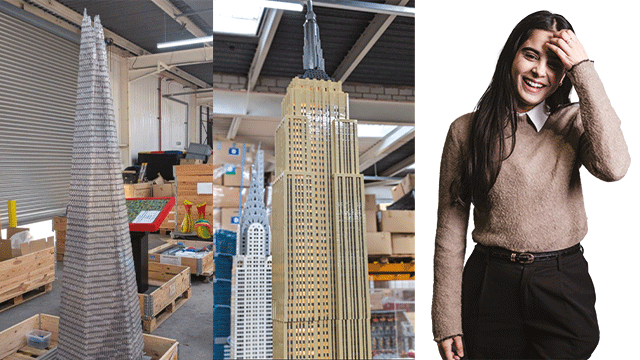 Once is an accident, twice a coincidence, three times is a trend. So with the Burberry and Legal & General deals, is Yorkshire manufacturing on the brink of a resurgence?
Once is an accident, twice a coincidence, three times is a trend. So with the Burberry and Legal & General deals, is Yorkshire manufacturing on the brink of a resurgence?
Don’t be too sure. Manufacturers are certainly on manoeuvres – some of them inspired to find new premises by the winter’s damaging floods. But it may be too soon to declare that making things has replaced moving things as the mainstay of the Yorkshire industrial property market.
The Burberry deal – which sees the iconic label move to a three-acre site at Holbeck – is undoubtedly an eye-catcher. It announced in November 2015 that it was to invest £50m at Temple Works with completion pencilled in for 2019.
The first phase will see an area of the South Bank site redeveloped to create a new facility that will offer increased capacity for trench coat production, with the potential to develop and produce other products at the site. Subsequent phases including restoring the Grade I listed Temple Works building. The works were to have been an arts centre, had a Heritage Lottery Grant not fallen through. Now it will become a temple to fashion.
The facility will replace the two existing Yorkshire manufacturing and weaving centres in Castleford and Cross Hills.
Details of Burberry’s deal and its current plans are hard to come by. Public consultation on the development is not expected until the autumn, and a start to work unlikely until early 2017. A question mark hangs over the refurb of the listed Temple Works façade, with well-informed sources suggesting it is an aspiration rather than a cast-iron commitment.
Burberry said in a statement: “We are currently undertaking detailed studies of Temple Works and the surrounding area to see whether or not they can form part of our future phases of development either alone or in partnership with other businesses. Burberry’s in-house architecture team is working alongside Stanton Williams, a Stirling prize-winning practice.”
Modular manufacturing
Legal & General’s move is more transparent. It took 550,000 sq ft at Logicor’s Big 555 unit at Sherburn-in Elmet, 15 miles east of Leeds.
The unit is for its new modular housing business, Legal & General Homes, producing precision-engineered factory manufactured homes. Initially employing 400 to 500 local people, it expects to deliver its first houses in June.
The requirement had been in play since 2014, for much of that time in the name of Manchester-based Ty Haus. Eventually Ty Haus made an arrangement with L&G – but by that stage the supply of 500,000 sq ft units in the UK had dwindled to one.
Luckily for Logicor, work to combine two units into one at its site close to junction 42 of the A1(M) coincided with the revival of the now well-backed Ty Haus/L&G requirement.
L&G acknowledge that by this stage, it didn’t have much choice of location. A spokesman said: “Our minimum requirement was 500,000 sq ft in order to house the size of equipment and long production lines needed.
“We needed a building of significant size to be able to build the houses all in one unit.
“Scale was a major factor in the decision due to the size of the equipment and long production lines needed to efficiently deliver thousands of modular houses per year.”
Mike Baugh, senior director at CBRE and an adviser on the deal, says: “The timing couldn’t have been better for Logicor. We’re seeing more enquiries from manufacturers – especially looking for units under 50,000 sq ft.”
Logicor is delighted, too. It was lucky that the unit has a substantial floor meeting manufacturer’s specifications above those of most warehouses. Sherburn is 65 kN/sq m– compared to 45-50 kN/sq m in standard warehousing.
Mike Best, director at Logicor, says the floor – and the size of the unit – were critical. “We didn’t envisage a manufacturing occupier when we bought this, but L&G liked it. They are going to invest heavily, so hopefully they will be a tenant for longer than the 10 years they’ve signed for,” he says.
“The better the floor, the wider the appeal of the building,” says Best, who reckons improving the floor’s strength to 65kN/sq m probably adds about £2 per sq ft to construction costs.
“So long as yields are 6% or less, with rents rising, that’s the kind of thing developers might do.”
Muse Developments has gone for a standard floor of 50kN/sq m at Logic Leeds, the 110-acre distribution park next to junction 45 of the M1 motorway. Even so, the scheme is still attracting manufacturing interest for the 81,000 sq ft first building.
Muse director David Wells explains: “Manufacturers are finding it hard to find suitable buildings, so we’re starting to get more enquiries from manufacturers looking to expand or modernise.”
While Muse hasn’t increased the floor loadings, it has increased the electricity capacity to meet manufacturer’s needs. The Logic Leeds unit is 500 kVA, about twice the capacity a distribution user might require.
“The cost is in the electrical equipment which you need whatever the power throughput, so increasing the kVA wasn’t a big expense,” says Wells, who says construction costs were about £50 per sq ft on a unit which always assumed a manufacturer might be the tenant.
No fast track to success
So is Yorkshire on the brink of a manufacturing renaissance? That might be going a bit far.
Rob Oliver, director at Bilfinger GVA, is among those slightly perplexed by Burberry’s decision to move to a city centre site – and he doesn’t see Yorkshire’s manufacturers accelerating in the way that the auto sector has prompted growth in the North West.
“They’ve the Jaguar Land Rover supply chain stimulating demand in the North West – and we don’t have anything like that in Yorkshire,” he says.
“Yorkshire’s manufacturing sector is steady, not giddy, and the implications for property are limited.
“The energy sector supply chain, which was big for Yorkshire in the earlier part of the decade, is now going through problems thanks to the fall in oil prices, so we can’t even rely on them,” he adds.
That third big Yorkshire manufacturing deal seems like wishful thinking.
Burberry’s Holbeck deal
Burberry has been as buttoned-up as its famous trench coat about the details of its Holbeck site. However, EG can reveal that the three-acre Temple Works site (land west of Marshall Street) was the subject of an option in November 2015.
Temple Works Ltd – registered at the London address of Burberry’s lawyers Pinsent Masons, with directors including Burberry financial director Carol Fairweather – was the beneficiary. Arndale Properties and Temple Studios granted the option. The site last changed hands in 2012 for £1.5m plus VAT. A planning application isn’t expected until the end of the year. It isn’t yet clear how large the site will eventually be, still less the size in square feet.
Leeds City Council is expected to sell land at Bath Road, Sweet Street and Leodis Court to Temple Works.
Legal agreements are expected to be completed by early summer.
Making it big
Specialist manufacturing is big news in South Yorkshire, where the Advanced Manufacturing Park is mopping up tenants prepared to pay the roughly £1 per sq ft premium on rents. A metals coating business is understood to be the latest new arrival, paying around £6.50 per sq ft on a 22,000 sq ft unit.
Developer Harworth is responding with another 52,000 sq ft development of six units. “It has real appeal to specialist occupiers,” says Rebecca Schofield from the Sheffield office of Knight Frank.
In Hull, Siemens’ £160m investment in wind turbine production and installation facilities in Yorkshire is expected to stimulate the supply chain.
Scott Morrison, senior surveyor at Cushman & Wakefield, says: “This kind of advanced manufacturing could come to sites around the region. We’re targeting it at Goole 36, the 95-acre Homes & Communities Agency site, and we’ve already got some interest.”











